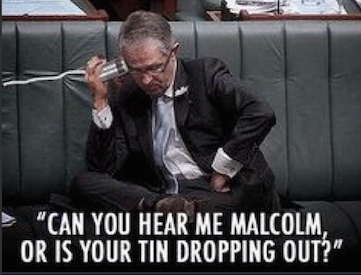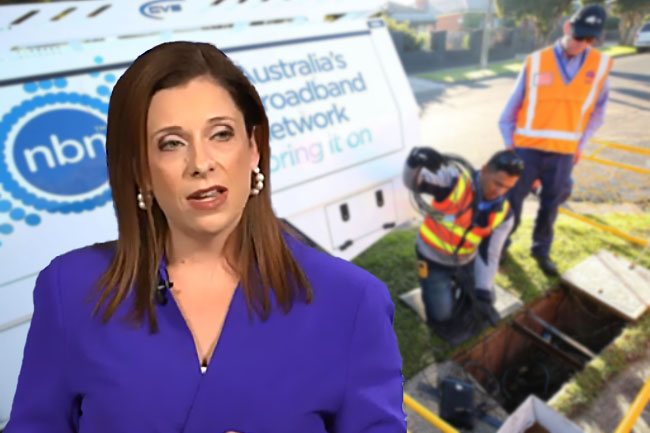The NBN goes against the very principles of conservative government.
This again became very clear to me in my discussion with the Joint Standing Committee on the National Broadband Network.
When addressing the various well-documented problems of the NBN the chair of the committee repeatedly mentioned in defence of the current multi-technology-mix (MtM) policy that many other counties were also not deploying national fibre to the house (FTTH).
However, I argued that there is a huge difference between a government-led rollout of high-speed broadband and one led by commercial organisations.
It is most certainly true that in many countries FTTH is first employed in those markets that are prepared to pay a premium (approximately 20-25% of the total population) and then over time, when prices come down, these services filter down to the markets below.
Labor steps up attack after NBN admits there’s no budget to deliver better service #nbnFail #MalcolmsFolly https://t.co/6L0pbZ4hln
— Terry Serio (@TerrySerio) August 30, 2017
This could also have been the case in Australia. However, the situation here in the early and mid-00s was very different, with Telstra holding the single largest national telecommunications monopoly among the developed economies. Under the leadership of its then CEO, Sol Trujillo, the company relentlessly pursued a strategy to maximise its monopolistic position and used that position to dictate the way it wanted to upgrade broadband in Australia. They proposed a plan to bring fibre to the node (FTTN) to around 50% of all Australians and requested a regulatory holiday that would allow them to charge a monthly $85 wholesale charge.
As a consequence of Telstra’s behaviour – in the run-up to the 2007 Federal Election – there was bipartisan support for a structural separation of Telstra.
But before that, the ACCC had already rejected Telstra’s proposal and the Howard Government of the time proposed a plan for a regional broadband network, as this was the area where the broadband service was the poorest. Telstra sued the Howard Government for interference in their market and the situation rapidly deteriorated.
The Rudd Labor Government that came into power in 2007 proceeded with the regional broadband plan, so in this situation also there was bipartisan support. Also important here is to recognise that Helen Coonan, the Communications Minister under the previous Liberal Government, had already recognised the need to expand broadband in non-commercial areas with her OPEL initiative; this somewhat limited initiative was cancelled by the incoming Labor Government.
The 2008/2009 global financial crisis (GFC) saw the Rudd Government launching large-scale economic stimuli investments and for the NBN, this resulted in a quantum leap from just a regional plan to a national one.
While the pros and cons of the overall stimulus package (including the NBN investment) are still debated, a 2017 poll commissioned by the Australia Institute did find that 62% of voters believed that the total stimulus package kept Australia out of recession in contrast with other major developed economies.
RECAP: Ten years on, voters say Labor's $52bn stimulus saved Australia from recession https://t.co/TweSHZBP7x#Auspol #LNPfail
— Ray Marx & RKD (@marxdeane) August 27, 2017
Nevertheless, at that time the Liberal Opposition had swung to the right and as a consequence, saw any government interference in the market as blasphemy. Bipartisan support disappeared and the economic stimulus projects were bitterly opposed and politically undermined, in particular by the Opposition’s new leader, Tony Abbott.
Using the stimulus policy in relation to the NBN, the Labor Government decided to break through the Telstra stranglehold and stop them from dominating and dictating the national development of essential digital infrastructure; and to build structurally separated (wholesale-only) national FTTH infrastructure. That decision was based on the national interest and would provide a ubiquitous service for all Australians. (Of course, this also fitted in well with the more socially inclined policies of a Labor government).
However, this didn’t sit well with the Liberal Opposition (and later government) and Tony Abbott went as far as proclaiming that he would kill the NBN. In the witch-hunt that started soon after the election, the ACCC was demonised for supporting FTTH and accused of having influenced the NBN expert panel, as if these experts couldn’t make up their own mind. A new expert panel was established with mainly Liberal-devotees.
Nicely played Tony Abbott. Kill off #nbn and your more popular rival at the same time.
— Lyn Calcutt (@Hobjobblesmum) April 9, 2013
The problem here is that conservatives don’t share the notion of government-driven national equality policies and would have preferred a more staggered market-driven approach with more limited support on an as-needed basis only.
The reality, however, was that this was not possible in the period 2005-2009 when Telstra exercised relentless use of its monopolistic position.
This is an important point to make as, under the leadership of David Thodey (since late 2009) and the current CEO Andy Penn, a more conciliatory and cooperative solution could have been found. Unfortunately, we can’t turn the clock back and it is important to look at the NBN policies from the perspective of the situation during the 2005-2009 period.
Again theoretically, based on Coalition ideology it would perhaps have been better to sell the NBN off in 2013 (accompanied by proper regulations). However that would have meant financial chaos and another three years of regulatory and legal delay, so that was not a real option. But it is worthwhile to note that a government-led NBN does not sit well within conservative political thinking and so, in principle, they will forever have a problem with the NBN.
That position was very clear to me during my discussion with the Senate Committee. A good example was that the Coalition Senators kept on comparing the way that the USA and the UK, for example, are pursuing FTTH and arguing that these countries are not deploying FTTH nationwide.
My argument here was that the difference is that the carriers in those countries are commercial organisations. In Australia, it is the government that is doing this job and as such, the underlying policies, strategies and business models between these two situations are totally different.
The Australian Government can’t just follow a commercially-driven business model, as in that case it would have to reduce the roll out to, say, 50% of all Australians. The way the NBN is currently being rolled out – which would not be easy to change – means that the Government will have to treat it as a national interest project and, that as such. some of the costs need to be seen as a social investment, similar to many other national infrastructure investments.
Fact check: Has Australia's internet speed dropped from 30th to 60th in the world under the #COALition? #NBNfail https://t.co/wRURnyOtt0
— SusanTaylor (@suzlette333) September 5, 2017
The extra cost of building a national network based on government policies should not burden the commercial elements of the NBN – as it currently does, hence the many problems – as otherwise, the price to the end-users would simply become unaffordable for most of them. It is very clear that Coalition politicians are struggling with this reality.
Muddling on will mean fewer people taking up the NBN and especially its higher tier packages and more people will simply stay with their current services (unless the Federal Government forces them away from them) and/or they will revert to using the mobile services for their broadband requirements. The 5G technology will allow mobile operators to provide users with more broadband capacity without increasing the price, therefore decreasing the gap between affordable broadband from fixed and mobile networks.
Most of the current problems that the NBN is facing can be brought back to the fact that a government-led national interest project such as the NBN goes against the very principles of conservative government. So the current situation requires a political solution — either the government accepts its responsibility based on policies it doesn’t support, or it quits the project and hands it back to private industry at the cost of a massive write-down.
The NBN company, the RSPs and everybody else are caught between a rock and a hard place and can’t solve the many NBN problems without the Coalition Government first sorting out its political stand on the NBN.
Listen to Paul Budde speaking at the Joint Standing Committee on the National Broadband Network:
Paul Budde is managing director of Paul Budde Communication Pty Ltd (budde.com.au), an independent telecommunications research and consultancy organisation. You can also follow Paul on Twitter @paulbudde.
This article was originally published on BuddeCom and is republished with permission.
Latest #NBNfail: Taxpayers to pay for broken network with new 'broadband tax' https://t.co/ZxW95Rfze4 @IndependentAus
— SusanTaylor (@suzlette333) May 26, 2017

This work is licensed under a Creative Commons Attribution-NonCommercial-NoDerivs 3.0 Australia License
Monthly Donation
Single Donation
Stay in touch. Subscribe to IA for just $5.











